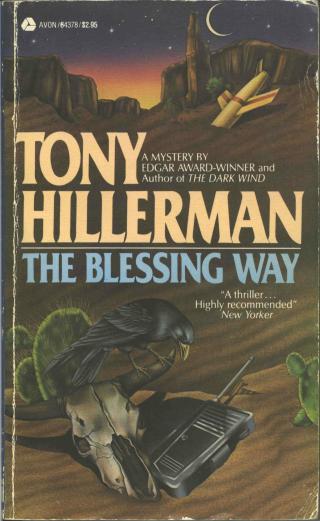Tony Hillerman’s The Blessing Way established the set of themes, concerns, and characters on which Hillerman would elaborate during his accomplished career as an author of fiction and nonfiction. Most notably, The Blessing Way marks Hillerman’s momentous contribution to the detective story, a genre that emerges in the nineteenth century with early masters such as Edgar Allan Poe and Arthur Conan Doyle, and is developed by Raymond Chandler, Agatha Christie, Dashiell Hammett, and Patricia Highsmith, among others, in the early to mid twentieth century. Hillerman takes the major concerns of the detective story and adapts them to the unique landscape of the American southwest. In so doing, Hillerman dramatizes how any knowledge of the southwest must be deeply historical. The simple question of “Whodunit?” is never answered simply in Hillerman’s novels. As Nicolas Witschi claims, “Hillerman renders the landscape as a palimpsest of information drawn not only from multiple cultural sources but also from the ineffable understanding that comes from having a direct experience of the region” (390). In Hillerman’s detective novels, crimes resonate with history and tradition. In order to understand the murder of Luis Horseman that is at the center of The Blessing Way, for example, one needs to encounter not just life in the southwest during the 1960s or early 1970s, but also ancient Pueblo sites, Navajo belief systems, contemporary archeology and ethnography, and the United States military’s presence in the region.
The clearest way that Hillerman deviates from the rationality of the detective formula—the idea that the detective solves a crime by deduction and by unmasking superstition—in The Blessing Way is in his representation of detective Joe Leaphorn and anthropologist Bergen McKee’s relationship. In this passage, McKee, a UNM anthropologist who studies witchcraft in Navajo culture, glosses over his relationship with one of Hillerman’s signature characters:
Leaphorn had been of immense help in his original research, arranging to open the
Law and Order Division files to him and helping him find the sort of people he
had to see, the unacculturized Indians who knew about witchcraft. He had always
regretted that Leaphorn wouldn’t completely buy his thesis—that the Wolf
superstition was a simple scapegoat procedure, giving primitive people a
necessary outlet for blame in times of trouble and frustration. (Hillerman 23)
Indeed, Leaphorn is a detective who represents modern “Law and Order” but who also “[knows] the old and patient ways,” a modern detective and also a figure steeped in traditional culture (Hillerman 90).
Interestingly, at the conclusion of The Blessing Way, the secret that remains is not related to these “old and patient ways” but instead to the United States military. The murders and abductions in The Blessing Way are fueled by a spying operation, concerned not with ancient Pueblo ruins or Navajo Wolves but with missile testing from “the Tonepah Range up in Utah down to the White Sands Proving Grounds” (Hillerman 266). To uncover this operation, though, one must know both the ancient and the modern, both traditional belief systems and the Cold War military-industrial complex. This is what makes The Blessing Way, and Hillerman’s detective stories more generally, so interesting: their representation of how a knowledge of history, landscape, region, and tradition is necessary to any understanding of a contemporary event. To understand anything, you must know everything. This is an ambitious yet worthwhile imperative.
Works Cited
Hillerman, Tony. The Blessing Way. 1970. New York: Harper, 2009.
Witchi, Nicolas S. “Detective Fiction.” A Companion to the Literature and Culture of the
American West. Nicolas S. Witschi, ed. Malden, MA: Wiley-Blackwell, 2011.
380-394.


